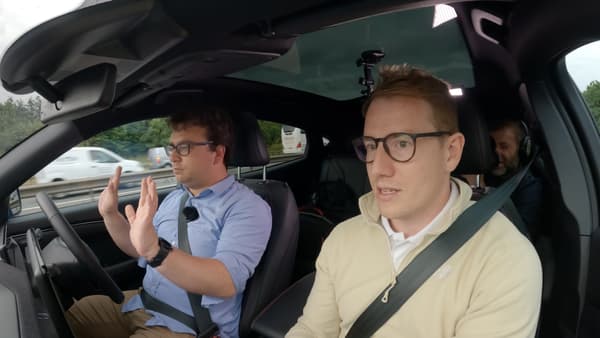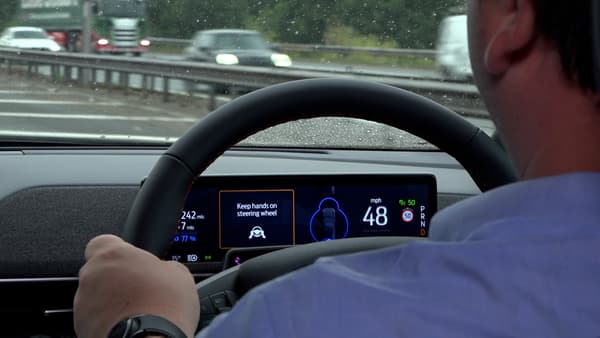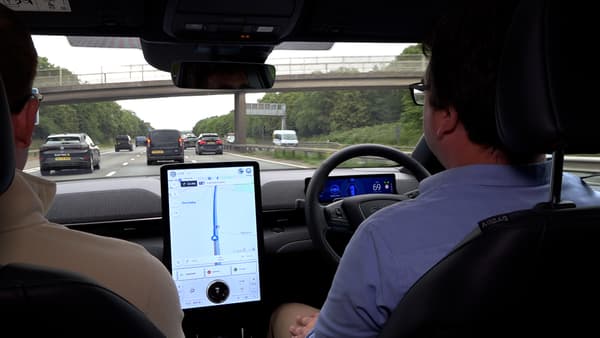Driving assistants are constantly improving. More and more modern cars are equipped with so-called driving functions. “semi-autonomous” or level 2, according to the accepted classification.
Here, the vehicle knows how to adapt its speed according to the traffic in order to potentially stop and follow the lines of the road. Clearly, it is no longer necessary to touch the steering wheel or the pedals, but the driver must always be able to regain control.

After Mercedes, another approach to “without hands”
To ensure that the driver respects this instruction, as the latter is often tempted to do more than just look at the road, the most common rule is to hold the steering wheel. With various technologies out there – at Tesla, and its famous Autopilot, for example – it is sometimes necessary to move the steering wheel slightly to indicate its presence. In Volkswagen, the capacitive steering wheel detects the presence of the hands on the wheel and therefore it is not necessary to make this small movement regularly.
But in Europe, exceptions to this sacrosanct rule of holding this steering wheel even in (very) assisted driving are beginning to appear. Already since last year, with the first autonomy technology called level 3 marketed by Mercedes in its top-of-the-range models, Class S and EQS. This level 3 allows you to do something else while the vehicle fends for itself, in a very specific environment. You can read, write an email or text, but not sleep or change places in the vehicle… on predefined highway sections (only in Germany at the moment) and up to 60 km/h. Therefore, in situations of traffic jams or heavy traffic.

Second exception now with Ford, which remains at level 2 of autonomous driving. Therefore, it is not about doing anything other than monitoring the road, but with the advantage of being able to be activated at high speed: this system “without hands” it can operate up to the maximum authorized motorway speed: in this case 70 miles per hour (112 km/h) in Great Britain, where the feature has been deployed on the Mustang Mach-E since last April, a first in Europe.
A natural replacement for the driving assistant
this technology “blue cruise” It has been available for 2 years in the United States in Ford and Lincoln models and is therefore coming to Europe, for now only in the Mustang Mach-E marketed in 2023.
For earlier models, you must have taken the option packages (“technology” EITHER “Technology+”) that provide the necessary sensors, radars and cameras. It was aboard one of these vehicles that we were able to test the feature on a motorway, the M11, south-east London in early July.

The authorization of the British authorities delimits “blue zones” (blue areas) where the function “free hands” (no hands) can be activated – just over 6000 kilometers currently on motorways in England, Wales and Scotland.
Once the driving assistant (adaptive cruise control with line following) has been activated, the car detects via GPS that it is on a compatible highway. You can then enable this feature “blue cruise”. In the event of a speed limit change, a notification informs you to change the speed limit entered in cruise control.
A driver “under surveillance”
Few changes at last with the classic assistant, with the difference that you can put your hands on your thighs and look at the road.

In fact, two infrared cameras placed behind the steering wheel scan your eyes. It diverts your attention for a few seconds and you are called to order, first with visual and audible signals, then with a slight braking signaling you to regain control, which we were able to test as you can see in our test video.
If the driver does not react, which we have not tried for safety in front of the rest of the road users, the scenario foresees a progressive deceleration, until stopping, with activation of the warnings, but staying in his lane. It is always good to know in case of driver discomfort, for example.
Lane changing is not automated: if a vehicle is moving slower in front of you, the vehicle will adapt its pace. To pass it, you simply have to take control of the steering wheel, activate the turn signal (which, in addition to warning other users, deactivates lane keeping), and change lanes, where the “blue cruise” reactivates automatically.
Finally, at the exit of a “blue Zone”The system invites you to put your hands back on the wheel, which you do anyway to take the exit lane of the highway, returning to the classic assistant.

Coming soon to continental Europe
The experience, therefore, is quite conclusive… even if you don’t quite know what to do with your hands, which are rather used (still happy) to stay on the wheel when driving. “directs”. Except here we don’t really drive anymore, just keeping our eyes on the road. Seeing on a long trip what this gives compared to conventional assistants, with hands on the wheel, which already gives the driver a lot of rest with a much more global concentration on the road.
We were able to test this feature at top speed on British motorways, ie 70 miles per hour (112 km/h), but the system could work at 130 km/h in France, Ford assures us. With the hope of being able to deploy this technology there by the end of the year or in 2024.
The next market to benefit is likely to be Germany, with no word yet on whether the system will be able to operate at 130km/h or higher on the unrestricted portions.
In reality, everything depends on the adaptation of the national regulations, which remain quite cautious for the moment about these initiatives towards 100% autonomous driving. At the beginning of 2017, we were already testing a Citroën prototype in motion “without hands”, with the ability to look the other way even at 130 km/h on the highway. A look in the rearview mirror shows that if the technology is well mastered, it is still much more complex to offer these types of functions to the general public.
Another important aspect: the price. In Great Britain, Ford offers this feature on a subscription basis, at £17.99/month (about 21 euros) with a 3-month free trial. A rental to add to the price of the Mustang Mach-E that currently starts at 56,990 euros in France.
Source: BFM TV

